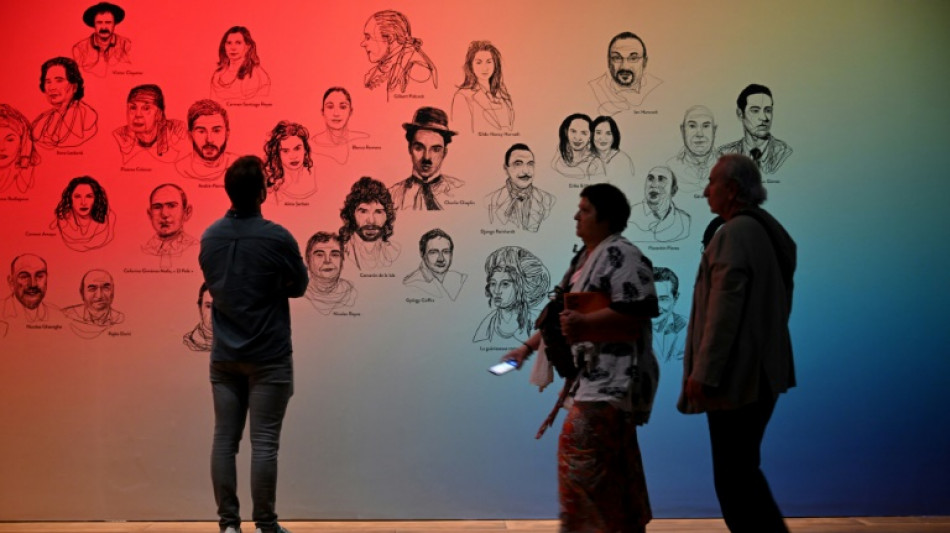
CMSC
0.0200

The faces of the Roma community's best and brightest beam down at visitors from a multicoloured wall inside one of France's top museums.
There is world-famous British comic Charlie Chaplin, Belgian jazz great Django Reinhardt and Alfreda Markowska, a Polish woman who during World War II saved dozens of Jewish and Roma children from a Nazi death camp.
"It's very moving," said Romani-Romanian academic Cristian Padure, admiring the exhibits inside the MUCEM museum in France's second city Marseille.
The show, whose title "Barvalo" means spiritually or materially rich in the Romani language, is the first such exhibition to draw together contributions from so many artists and curators within Europe's Roma minority of 12 million.
Padure said it was "recognition" of the community's contributions to European culture and history after centuries of discrimination.
In Romania, where the linguist grew up, Roma were slaves for five centuries until the 19th century.
Among the show's exhibits is an antique ad drawn from the country's archives that advertises "a young gypsy" for sale for 29 coins.
On another wall are so-called "anthropometric cards" of Roma living in France in the early 20th century, complete with racist measurements, mugshots and fingerprints.
All French Roma -- who call themselves Sinti, "gitans" or travellers -- were required to carry the identity documents, which were designed to limit their movement and paved the way for their deportation during World War II.
- 'Shape the narrative' -
The Nazis and their allies killed up to 500,000 Roma during that period, according to the US-based Holocaust Museum.
The exhibition highlights the work of late Romani-Austrian writer and artist Ceija Stojka, who wrote about and painted the horrific ordeal after surviving three separate death camps.
It also shines a light on Romani members of the French Resistance during the Nazi occupation.
"We too had forefathers who fought in all the wars," said Sylvie Debart, whose French Sinti grandfather Marius Janel was part of the underground army fighting the Germans.
But "travellers sadly are only ever in the news when they stop their caravan somewhere," she said.
US anthropologist Jonah Steinberg spent years lobbying to hold the exhibition.
"It's one of the first times that Roma history, art and culture has been presented at such a scale," said the professor at the University of Vermont.
"But most of all, it's unique because it is driven by Roma community voice, vision, experts, advisors, artists and guides."
Anna Mirga-Kruszelnicka was one of 19 people -- mostly Roma -- to help organise the exhibition.
"For once, in this way, we could shape the narrative about us," said deputy head of the European Roma Institute for Arts and Culture.
Romani artist Emanuel Barica sketched all the black and white portraits of famous Romani people on the museum wall.
"Perhaps people who are racist -- who discriminate -- really like Charlie Chaplin and didn't realise he was Romani," said the 28-year-old, who was bullied at school in Romania before moving to Germany.
"Perhaps they'll change their point of view."
Chaplin in his autobiography said his grandmother was "half gypsy".
- 'See our humanity' -
Earlier this week, AFP saw a group of Romani teenagers who had at least partly grown up in Marseille's slums tour the exhibition with stars in their eyes.
On Barica's wall of fame are also Pierre-Andre Gignac, who has played on the French national football team, and Alina Serban, the first Romani playwright to see one of her plays added to the repertoire of a Romanian state theatre after growing up in a shack and orphanage.
"For me, for my community, this exhibition is like achieving the impossible," said 35-year-old Serban, who has won awards for her lead role as a boxer in 2019 German-Austrian film "Gypsy Queen".
"It's essential to show contributions not stereotypes so that others can see our humanity," she said.
Romani-Italian artist Luna de Rosa, 31, said she hoped the show would help bring about social change.
"Sometimes, when society has so much prejudice against an identity, you start yourself to believe in this prejudice," said the artist, who is exhibiting a collage in Marseille.
"This exhibition can give self-confidence to young Roma who often go to school and are ashamed of their identity."
M.J.Baumann--NZN